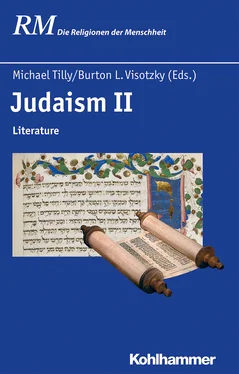Part of the explanation for the virtual lack of differences between the copies of MT in early times and through the centuries, may be found in rabbinic traditions regarding precision in the copying of scrolls: the existence of master copies of the Torah books in the Temple Court, 16and the correction procedure of scrolls according to these master copies. On the basis of these traditions, it may be postulated that the Judean Desert scrolls were in fact »corrected copies« that circulated in ancient Israel.
2.2.2 Rabbinic Traditions about the Use of Corrected Scrolls
The precision of the scribes of proto-MT is often mentioned in the rabbinic literature and this information exactly fits the scribes of proto-MT. On several occasions, rabbinic literature mentions a »corrected scroll« ( sefer mugah ). 17Furthermore, according to later rabbinic tradition, the Temple employed professional »correctors« whose task it was to safeguard precision in the copying of the text ( b. Ketub. 106a): 18»Correctors ( maggihim ) of books in Jerusalem received their fees from the Temple funds.«
This description implies that the correcting procedure based on the master copies in the Temple was financed from the Temple resources that thus approved of the copying procedure. This was the only way to safeguard the proper distribution of precise copies of Scripture. These scrolls must have been used throughout the land of Israel, for public reading as well as for instruction, public and private, as suggested by b. Pes 112a, where one of the five instructions of R. Akiba to his student R. Simeon was: »And when you teach your son, teach him from a corrected scroll.« Another such precise copy was the »Scroll of the King,« which accompanied the king wherever he went. y. Sanh 2.20c and Sifre Deuteronomy 160 19tell us that this scroll was corrected to »the copy in the Temple Court in accordance with the court of seventy-one members.« The »Scroll of the King« may well be an imaginary scroll and its description may be equally imaginary, but the reality for which it accounts, namely a practice of correcting scrolls from master copies, fits the reality of the copies of proto-MT and the precision of its scribes. In my view, the Judean Desert texts that are closely related to MT may well have been corrected copies.
2.3 The Forerunners of the Proto-Masoretic Text
2.3.1 Precise Transmission of Inconsistent Spelling
The aforementioned precision with which the proto-MT text was copied is not contradicted by the inconsistency of MT in orthography (spelling). Since the generations prior to those of the proto-MT scribes created an inconsistent text in matters of spelling, it was precisely this inconsistent spelling that was transmitted exactly to the next generations.
The lack of internal consistency within proto-MT pertaining to the insertion of the so-called matres lectionis , the vowel letters אהו"י ( aleph , heh , waw , yod ) that were inserted gradually in the Hebrew language in the course of the centuries to assist readers, is visible in the following two areas: Differences between the relatively defective orthographic practice of the majority of the biblical books and the fuller orthography of the late books Chronicles, Ezra-Nehemiah, Qohelet, and Esther.
2.3.2 Internal differences within the various books
It is clear that for ancient scribes, consistency in the use of these vowel letters was not as important as it was in later centuries. The lack of unity in proto-MT is further shown by examples of inconsistency in the spelling of words appearing in the same context or belonging to the same grammatical category, and of unusual spellings. This inconsistency also characterizes the textual traditions of the Samaritan Pentateuch, the so-called Qumran Scribal Practice of many Qumran scrolls, and most individual Qumran scrolls. The following examples bring this inconsistency to light:
Feminine plural ending -ot in the participle qtl(w)t, e.g. שמר)ו(ת.
A computer sampling shows that these forms are written with the full spelling of the final syllable in 22.4% of all instances in the Torah, while in 100% of them in the Writings (ketuvim).
The spelling of words belonging to the same grammatical pattern appearing in one context. An example is Ezek 32:29 ירדי בור as opposed to v. 30 יורדי בור (with the added letter waw ).
Many words appear in different spellings in the same context. An example is Judg 1:19 וירש compared with ויורש in the next verse.
Unusual spellings such as:
• מצתי (usual form: מצאתי) in Num 11:11
• ההלכוא (usual form: אשר הלכו) in Josh 10:24.
We do not know anything about the forerunners of MT, because we have no written evidence. However, from MT we can extrapolate their existence, and they tell us something about the scribes of MT. The scribes of the MT texts precisely copied their texts as we can see from:
1. The fact that a large number of texts remained unchanged over the course of 2000 years;
2. The exact copying of scribal features (see below, 2.3.3 on Scribal Marks). At the same time, other features seem to contradict this image of precision, namely
3. Inconsistent spellings.
4. Frequent mistakes in MT in certain sections. 20
Conditions (1) and (2) apply only if the scribes of MT started applying their rigid precision in copying a text that already contained the features described as (3) and (4).
The forerunners of the proto-MT scribes used several marks to communicate scribal information to later scribes. These practices were not invented by them for the copying of specifically biblical texts, but were used also in many of the biblical and nonbiblical texts found in the Judean Desert, including texts that did not have a Masoretic character.
Despite the intention of the original scribes who made these marks, the scribes of MT sanctified the totality of the written surface of the texts they copied, and thus included these scribal marks, such as:
MT includes scribal dots under or above letters serving to denote letters that had been deleted by the scribes, as often occurring in the Dead Sea Scrolls. These dots were meant to delete details in the text because it was technically difficult to erase letters in a leather scroll, and these dots were not meant to be copied to the next scroll.
Because of the extreme care taken in copying MT, the dots that appeared in the text from which the proto-MT text was copied were now included in the new copies through the medieval texts and our printed editions.
These dots had to be reinterpreted by the Masoretic tradition and they were now considered doubtful letters. Named »special dots« ( puncta extraordinaria ) within the Masoretic tradition, these dots, above the letters, show the strength of that tradition in preserving the smallest scribal details. For example:
Lot’s Older Daughter —MT has a dot over the waw of ובקוׄמה (»and when she arose«) in Gen 19:33, which refers to when Lot’s older daughter arose after cohabiting with her father. The rabbis suggest that the dot teaches that although the verse says, »he was not aware of her lying or rising« he was, in fact, aware of her rising. This makes his agreement to drink until intoxicated the next night much more problematic. The original meaning of the dot was simply to erase the letter and make the spelling defective, as it is with the description of the younger daughter rising in v. 35.
Читать дальше







